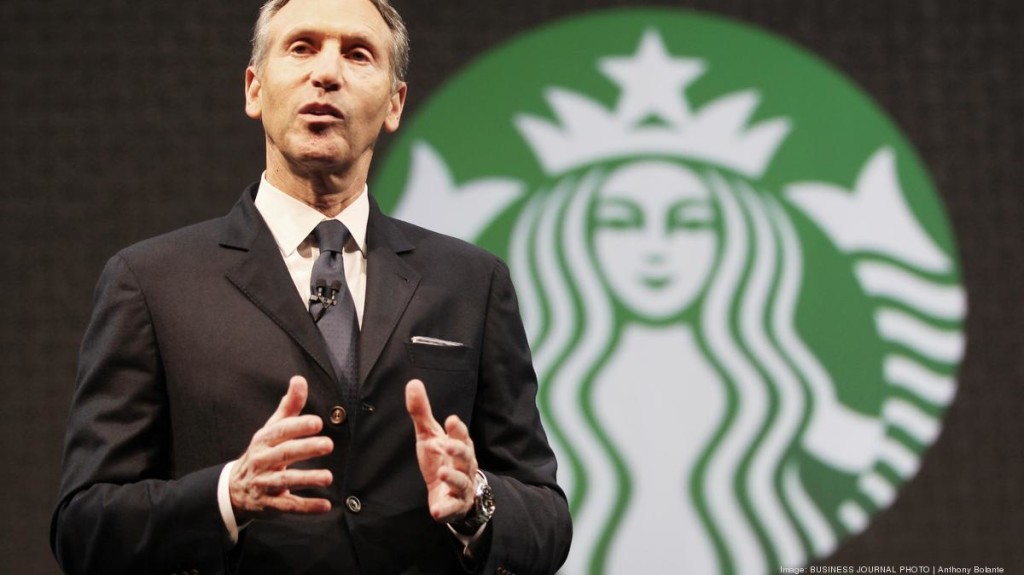Starbucks CEO Howard Shultz on how corporate social responsibility builds the bottom line, and personal responsibility builds our country.
“I guess I’m more of a sh*t than I realized,” a journalist was overheard saying at the Starbucks Annual Shareholder’s Meeting. “I could never work at Starbucks; the people who work here are just so excited about community service and helping others.”
And, as was made clear at the recent Starbucks Annual Meeting extravaganza in Seattle, nobody is more excited about community service and helping others than Starbucks CEO Howard Schultz.
“We are a performance-based company driven through the lens of humanity,” Schultz told the cheering crowd of shareholders and employees who had waited in line for hours to hear the Starbucks leader speak.
Coming off a mind-bending 54% share price increase in 2015, nobody on hand seemed eager to question that “performance” part of his equation, and, in fact, Schultz wanted to talk about the other part of that equation: humanity.
“Some people say social responsibility isn’t our job; that our only job is to try to make a profit. I reject that! I can tell you with much proof that it is accretive [adds value] to shareholder value. It is accretive!” he added, to additional applause.
Schultz and his lieutenants went on to detail some of the recent ways that Starbucks was adding social, not just shareholder, value:
– From here forward, every day, at every U.S. company-operated Starbucks store, non-expired perishable food items will now be delivered to those who are hungry or otherwise have pressing food needs.
– Starbucks will be joining the TurboVote Challenge in a technology-supported attempt to make it easier for employees to vote, as part of nonprofit Democracy Works’ larger goal of 80% voter participation in the 2020 election.
– By the end of this year, Starbucks’ One Tree for Every Bag program will have succeeded in donating an estimated 20 million rust-resistant coffee trees to farmers.
– Starbucks’ College Achievement Plan, a 100% tuition-free opportunity for employees to get a bachelor’s degree through Arizona State University, already has more than 5,000 partners enrolled.
– The company has already reached 70% (7,000 employees) of its 10,000-employee commitment for hiring “opportunity youth” (unemployed young people who are not in school) as well as being 25% of the way toward its even more ambitious 100,000 opportunity youth hiring goal, the 100,000 Opportunities Initiative, that Starbucks successfully goaded other corporate giants (Target, Walmart, etc.) to join in. In addition, Starbucks to date has hired 6,500 veterans and military spouses [here’s my Veterans Day article on this program] and is creating opportunities for veterans and military spouses with 20 dedicated Military Family Stores.
Schultz then went a bit contemplative on the raptly-attentive crowd, sharing with the audience his belief that individual citizens, not just politicians and political parties, need to increase civility and improve the discourse level in the country, not only every four years but ever day, in the face of what Schultz sees as increased partisanship, polarization and cynicism. He called on every American to “fill the reservoir of the American Dream back up not with cynicism, but with optimism. Not with despair, but with possibility. Not with division, but with unity. Not with exclusion, but with inclusion. Not with fear, but with compassion. Not with indifference, but with love.”
(In support of this portion of Schultz’s speech, the Starbucks organization placed two-page spreads in the New York Times and Wall Street Journal, posing two sets of words (“apathy,” “divisiveness,” “vitriol,” “pessimism,” etc. on the one hand; “unity,” “community,” “optimism,” “opportunity,” etc. on the other) placed above the simple message, “Every day, we have a choice.”)
This is, to my eyes, is not a case of a CEO forcing his principles, top down, in a dictatorial fashion, and forcing his employees to pay lip service to the same. Throughout the Starbucks organization, a similar enthusiasm for and commitment to community responsibility is widely visible, often in spontaneous, bottom-up efforts and initiatives. Walk around any floor of the company’s plus-sized headquarters in Seattle, and you’ll see blackboards and posters touting the number of volunteer hours a particular team of employee volunteers has put in on a particular project, or the current level of the Partner (employee) Cup Fund, an employee initiative whose value is in financially helping partners in need, including this formerly homeless barista, whose story I tell here.
Happily, Schultz and the Starbucks organization have found and continue to find a steady supply of employees at every level of the organization who are less jaded than my journalist friend with whom I opened this article. And the performance, so far, would appear to speak for itself.
This article was taken from here.

